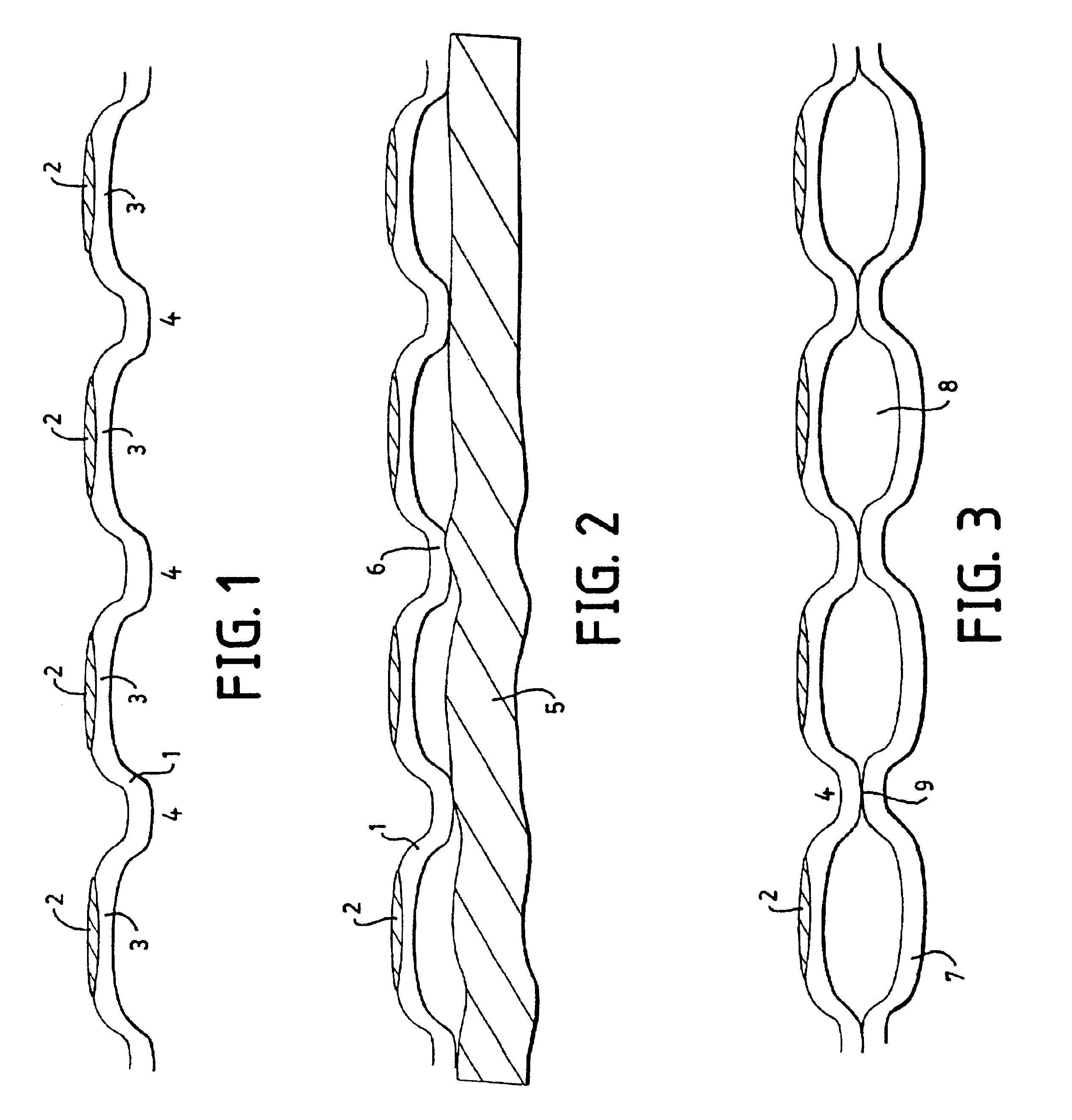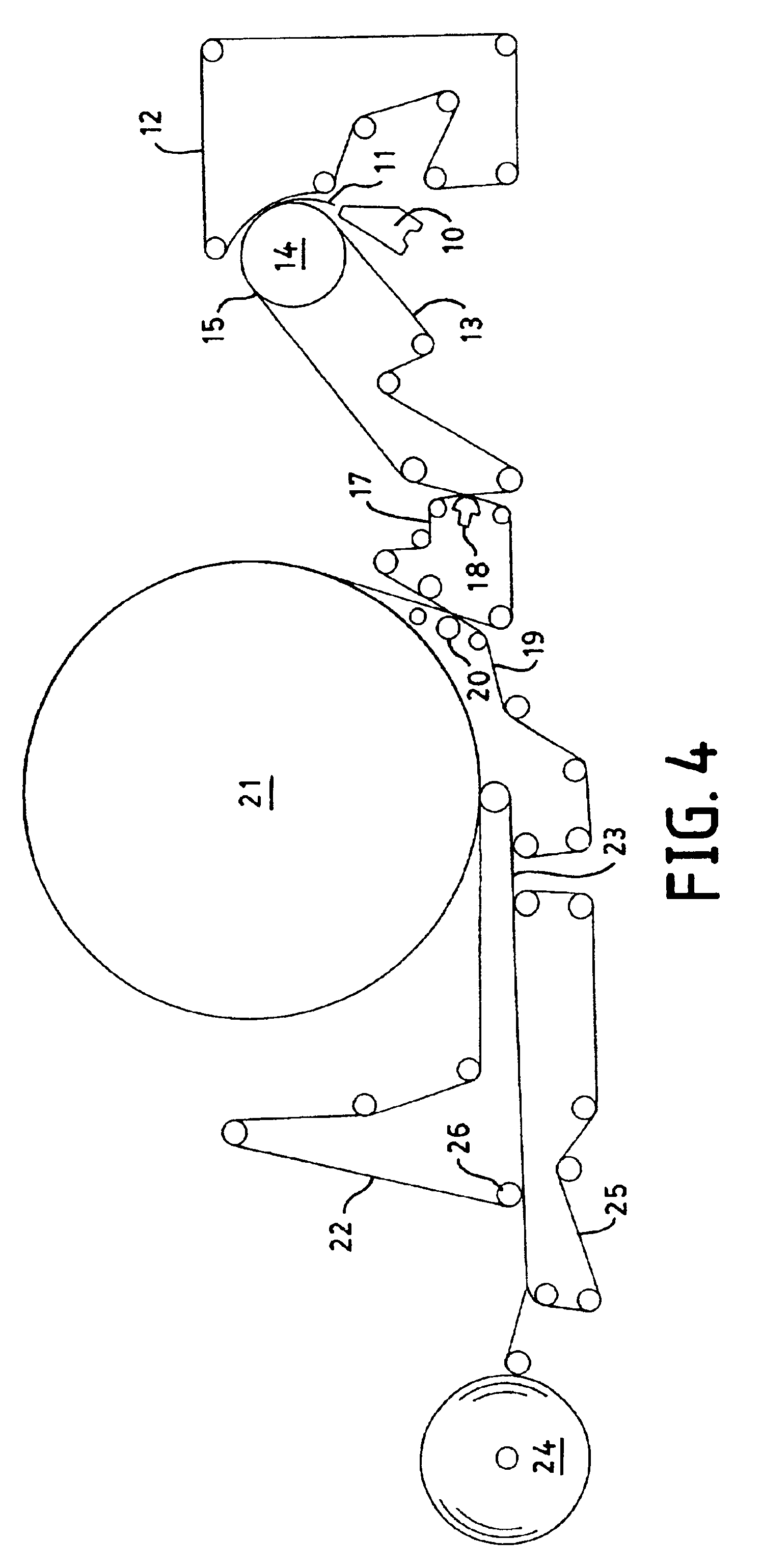Dual-zoned absorbent webs
a technology of absorbent articles and absorbent webs, applied in the field of dual-zoned absorbent webs, can solve the problems of wet feeling against the skin of the user, adversely affecting skin health, absorbent articles, leakage or seepage, etc., and achieve the effect of rapid z-direction (depthwise) transpor
- Summary
- Abstract
- Description
- Claims
- Application Information
AI Technical Summary
Benefits of technology
Problems solved by technology
Method used
Image
Examples
example 1
[0171]To demonstrate an example of a textured, wet resilient absorbent web with improved dry feel, a suitable basesheet was prepared and modified by addition of hydrophobic material in the form of paraffin. The basesheet was produced on a continuous tissue making machine adapted for uncreped through-air drying, similar to the machine configuration shown in FIG. 4. The machine comprises a Fourdrinier forming section, a transfer section, a through-drying section, a subsequent transfer section and a reel. A dilute aqueous slurry at approximately 1% consistency was prepared from 100% spruce bleached chemithermomechanical pulp (BCTMP), pulped for 20 minutes at about 4% consistency prior to dilution. The spruce BCTMP is commercially available as Tembec 525 / 80, produced by Tembec Corp. of Temiscaming, Quebec, Canada. Kymene 557LX wet strength agent, manufactured by Hercules, Inc., Wilmington, Del., was added to the aqueous slurry at a dosage of about 20 pounds of Kymene per ton of dry fibe...
example 2
[0176]In order to further illustrate this invention, uncreped throughdried tissue basesheet was produced using the method substantially as described in Example 1. More specifically, single-layer, single-ply tissue was made from unrefined northern softwood bleached chemithermomechanical pulp (BCTMP) fibers. After pulping and dilution of the BCTMP fibers, Kymene 557LX was added at 20 kilograms per metric ton of pulp. The forming fabric in this case was an Appleton Wire 94M fabric and the first transfer fabric was a Lindsay 956 fabric. Rush transfer was performed at the first transfer point, during the transfer from the forming fabric to the Lindsay 956 transfer fabric. The degree of rush transfer was 35%. The differential velocity transfer process used the vacuum shoe geometry taught in U.S. Pat. No. 5,667,636, issued Mar. 4, 1997 to S. A. Engel et al., previously incorporated by reference. At this second transfer point, from the transfer fabric to the through-air drying, both fabrics...
examples 3-6
[0181]In order to further illustrate a method of making absorbent webs of this invention, basesheets were produced using non-wet resilient northern softwood kraft fibers (NSWK), with and without a wet strength agent (20 lbs Kymene / ton of fiber), and wet resilient fibers (spruce BCTMP), with and without a wet strength agent (20 lbs Kymene / ton of fiber), using an uncreped throughdried process substantially as shown in FIG. 4.
[0182]The fiber was pulped at 4% consistency in the hydropulper for 30 minutes. The fiber was pumped into a stock chest and diluted to 1.0% consistency. 20# / ton of Kymene 557 LX was added to the stock chest and allowed to mix for 30 minutes. A single-layer, blended sheet of 30 gsm dry weight was formed on an Albany 94M forming fabric and dewatered with 5 inches (127 millimeters) of mercury vacuum. The forming fabric was traveling at 69 fpm (0.35 meters per second). The sheet was transferred at a 15% rush transfer to a Lindsay 952-S05 transfer fabric traveling at 6...
PUM
| Property | Measurement | Unit |
|---|---|---|
| Surface Depth | aaaaa | aaaaa |
| Surface Depth | aaaaa | aaaaa |
| height | aaaaa | aaaaa |
Abstract
Description
Claims
Application Information
 Login to View More
Login to View More - R&D
- Intellectual Property
- Life Sciences
- Materials
- Tech Scout
- Unparalleled Data Quality
- Higher Quality Content
- 60% Fewer Hallucinations
Browse by: Latest US Patents, China's latest patents, Technical Efficacy Thesaurus, Application Domain, Technology Topic, Popular Technical Reports.
© 2025 PatSnap. All rights reserved.Legal|Privacy policy|Modern Slavery Act Transparency Statement|Sitemap|About US| Contact US: help@patsnap.com



